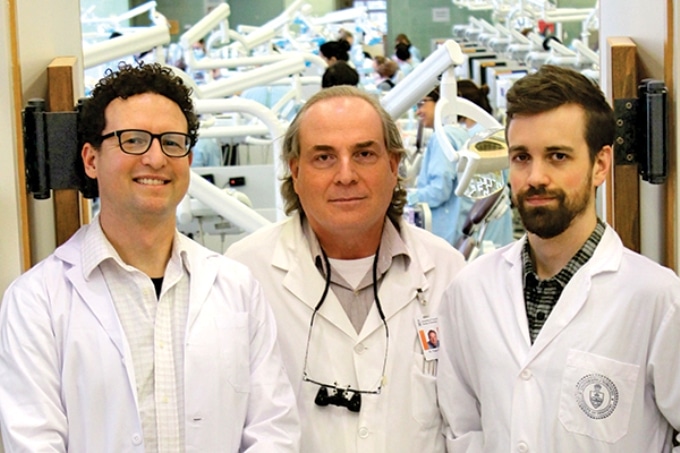Jan 31 2018
When patients visit the dentist to fill a cavity, they are trying to solve an issue - not develop a new one. But a number of dental patients receive bad news: bacteria can dig under their tooth-colored fillings and result in new cavities, known as recurrent caries. Recurrent caries affects 100 million patients annually and costs an extra $34 billion to treat.
 Professor Ben Hatton (MSE), Professor Yoav Finer (Dentistry) and Ph.D. candidate Cameron Stewart (IBBME) (Image credit: Faculty of Dentistry Yodit Tedla)
Professor Ben Hatton (MSE), Professor Yoav Finer (Dentistry) and Ph.D. candidate Cameron Stewart (IBBME) (Image credit: Faculty of Dentistry Yodit Tedla)
Currently, a research partnership between the Department of Materials Science & Engineering (MSE), Faculty of Dentistry and the Institute of Biomaterials and Biomedical Engineering (IBBME) at the University of Toronto has brought about a novel way to reduce recurrent caries.
In a recent paper published in the journal Scientific Reports, Professors Ben Hatton (MSE), Yoav Finer (Dentistry) and Ph.D student Cameron Stewart (IBBME) tackled the issue and recommended a novel solution: a filling material with minute particles created by self-assembly of antimicrobial drugs, designed to prevent bacteria in its tracks. These particles may solve one of the biggest issues with antibacterial filling materials: how do you store sufficient amounts of pharmaceutical drugs within the material to be effective enough for someone’s whole life?
Adding particles packed with antimicrobial drugs to a filling creates a line of defense against cavity-causing bacteria. But traditionally there’s only been enough drug to last a few weeks. Through this research, we discovered a combination of drugs and silica glass that organize themselves on a molecule-by-molecule basis to maximize drug density, with enough supply to last years.
Professor Ben Hatton
This finding of antimicrobials which self-assemble, means researchers can load 50 times as much of the bacteria-fighting drugs into the particles.
We know very well that bacteria specifically attack the margins between fillings and the remaining tooth to create cavities. Giving these materials an antimicrobial supply that will last for years could greatly reduce this problem.
Professor Yoav Finer
Going forward, the research team plans on analyzing these new drug-storing particles in dental fillings, tracking their performance when attacked by bacteria and saliva in the complex environment in the mouth. With some modification, this new ‘smart’ material could form a stronger filling and reduce the number of trips to the dentist.